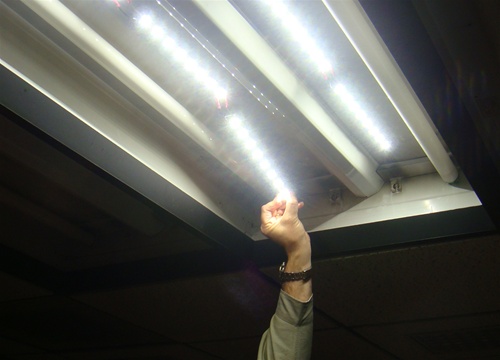Upgrading to LED
Retrofitting commercial LED lighting involves upgrading existing lighting fixtures with more energy-efficient and advanced LED technology. This process allows businesses and organizations to take advantage of the benefits offered by LED lighting without the need for a complete overhaul of the lighting infrastructure. Retrofitting is often a cost-effective and sustainable solution to improve lighting performance, reduce energy consumption, and enhance the overall ambiance of the space. Here are the steps involved in retrofitting commercial LED lighting:

Lighting Audit
Begin by conducting a lighting audit of your commercial space. A comprehensive one Identifying existing lighting fixtures, their types, wattages, and condition. Assess the lighting needs and requirements of each area to determine where LED retrofitting is beneficial.

Installation
Retrofitting LED lighting is generally straightforward and can often be done without professional assistance. However, for more complex installations or larger projects, it’s advisable to seek help from a licensed electrician or lighting specialist.

Choosing LED Retrofits
Look for LED retrofit kits that are compatible with your existing fixtures. There are various retrofit options available, such as LED lamps, LED tubes, LED troffers, and LED downlights, among others. Select products with the appropriate size, shape, and light output.

Check Compatibility
Ensure that the LED retrofit kits are compatible with your existing electrical infrastructure, such as ballasts & dimmer switches. Some retrofit solutions are designed to work with existing electrical systems, others may require modifications or removal of the old.

Efficiency & Output
When selecting LED retrofit kits, consider their energy efficiency and light output. Investigate products that have high lumens per watt (LPW) efficiency. This will ensure you are getting the maximum light output while minimizing energy consumption.

Verify Performance
Once the retrofit is complete, thoroughly test the new LED lighting to ensure that it meets your desired lighting levels, color temperature, and overall performance expectations. After careful measurement, make adjustments when necessary.
Benefits of Retrofitting to LED Lighting
Significant energy savings and reduced utility costs.
Longer lifespan of LEDs, resulting in reduced maintenance & replacement expenses.
Improved lighting quality and ambiance, enhancing the overall environment.
Lower carbon footprint and a more sustainable lighting solution.
Monitor Energy Savings
 Keep track of your energy consumption and cost savings after the LED retrofit. LED lighting typically consumes much less energy than traditional lighting sources, leading to reduced utility bills and a quicker return on investment.
Keep track of your energy consumption and cost savings after the LED retrofit. LED lighting typically consumes much less energy than traditional lighting sources, leading to reduced utility bills and a quicker return on investment.
Properly Dispose of Old Lighting
 Many lighting components, including fluorescent tubes and compact fluorescent lamps (CFLs), contain hazardous materials like mercury. Instead of throwing them in the trash, find a local recycling center or hazardous waste disposal facility that accepts these items. They can safely recycle or dispose of them in accordance with environmental regulations.
Many lighting components, including fluorescent tubes and compact fluorescent lamps (CFLs), contain hazardous materials like mercury. Instead of throwing them in the trash, find a local recycling center or hazardous waste disposal facility that accepts these items. They can safely recycle or dispose of them in accordance with environmental regulations.
A Final Word
Before proceeding with a retrofit project, it’s crucial to plan carefully, select the right LED products, and ensure compatibility with existing fixtures and electrical systems. And consult with experienced lighting professionals like Commercial Lighting Specialties who have the experience and know-how to offer direction and the best product fit as you plan your LED conversions. Retrofitting to LED lighting can yield substantial benefits in terms of energy efficiency, cost savings, and improved lighting performance in commercial spaces.


